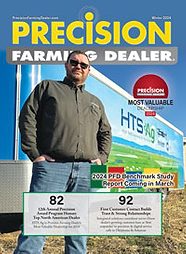As his HiLux ute bumped over hilly farmland outside Armidale, David Lamb kept a hand on the wheel and grabbed an iPad in the other to locate his herd of 50 ''smart'' cows.
Each cow is fitted with a tag in its ear that transmits its location to a digital map of the property.
Pausing briefly to look at the screen, Lamb could see where each cow - represented by a number and an icon - was located on the 2800 hectare farm.
This internet of cows has captured the imagination of farmers and others, said Professor Lamb, professor of physics and precision agriculture at the University of New England, which runs the Kirby SMART [sustainable, manageable and accessible rural technologies] Farm.
''Everyone says, 'Show us your cows, show us your cows','' he said. ''People see the eartags, they get it, and it captures the imagination.''
These tags make it easier to find stock, but they also indicate ''are the cows dead, being thieved or are they calving?''
Also being developed is the capacity to fingerprint a herd's movements, which could alert the farmer to feed levels or pasture preferences.
A bit later, Professor Lamb pointed to some of the 100 soil sensors that every five minutes transmit information about moisture, air and ground temperature to his iPad and to the farmhouse computer.
With programs such as Pastures in Space, which transmits satellite images showing the biomass of a field, farmers are cutting costs, improving yields and maximising each paddock.
Next week the university's smart farm, one of the first connected to the national broadband network, will be on show at the first Digital Rural Futures Conference.
Farmers and service providers have booked out the June 26-28 conference to hear case studies such as:
A Tasmanian vineyard attached sensors to vines to detect botrytis bacteria, the mould that makes delicious dessert wines but can ruin other grapes.
A wheat grower in Gilgandra cut his fertiliser bill by a third when he used a plant canopy sensor to apply fertiliser when and where it would make the most difference.
A cotton farmer doubled his yield per litre of water by using probes to apply water only where needed.
In a white paper to be released at the conference, CSIRO says broadband and sensor networks viable because of the NBN will ''transform'' farming and farmers' relationships with retailers, service providers and food processors.
The NBN will create broadband hotspots on all farms, sensor technology would create an internet of property information (and cows), and faster video conferencing would make it easier for service providers such as vets to provide remote services at affordable rates.
Many farmers have been slow to adopt technologies and connect.
But Colin Griffith, the director of CSIRO's Australian Centre for Broadband Innovation, forecasts the NBN will mean the widespread adoption of these tools within two to three years.
For farmer Lindsay Doyle, the reliability of a new fixed-wire and broadband network connected last September ''saved his business'' and allowed him to stay on the family farm 32 kilometres outside Tamworth. Before the NBN the connection was ''hopeless'', making him consider moving his quantity surveying business into town.
''I think there are many opportunities for family members to run businesses out of their homes so they don't have to move off the farm,'' said Mr Doyle.


![[Technology Corner] Future of Drone Use in U S Brighter After FAA Regulation Change](https://www.precisionfarmingdealer.com/ext/resources/2024/04/11/4-12-24-Slides_OTR14.jpg?height=290&t=1712932011&width=400)



Post a comment
Report Abusive Comment